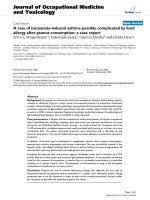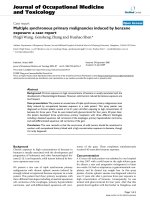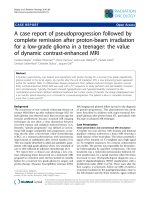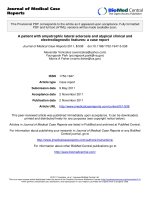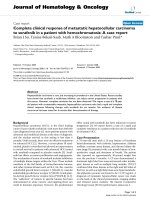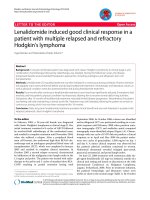severe nivolumab induced pneumonitis preceding durable clinical remission in a patient with refractory metastatic lung squamous cell cancer a case report
Bạn đang xem bản rút gọn của tài liệu. Xem và tải ngay bản đầy đủ của tài liệu tại đây (1.15 MB, 9 trang )
Li et al. Journal of Hematology & Oncology (2017) 10:64
DOI 10.1186/s13045-017-0433-z
CASE REPORT
Open Access
Severe nivolumab-induced pneumonitis
preceding durable clinical remission in a
patient with refractory, metastatic lung
squamous cell cancer: a case report
Hong Li1,2, Weijie Ma1, Ken Y. Yoneda3,4, Elizabeth H. Moore5, Yanhong Zhang6, Lee L. Q. Pu7,
Garrett M. Frampton8, Michael Molmen8, Philip J. Stephens8 and Tianhong Li1,4*
Abstract
Background: Programmed cell death 1 (PD-1) and its ligand 1 (PD-L1) inhibitors have quickly become standard of
care for patients with advanced non-small cell lung cancer and increasing numbers of other cancer types. In this
report, we discuss the clinical history, pathological evaluation, and genomic findings in a patient with metastatic
lung squamous cell cancer (SCC) who developed severe nivolumab-induced pneumonitis preceding durable clinical
remission after three doses of nivolumab.
Case presentation: A patient with chemotherapy-refractory, metastatic lung SCC developed symptomatic
pneumonitis by week 4 after nivolumab treatment, concurrently with onset of a potent antitumor response.
Despite discontinuation of nivolumab after three doses and the use of high dose oral corticosteroids for grade
3 pneumonitis, continued tumor response to a complete remission by 3 months was evident by radiographic
assessment. At the time of this submission, the patient has remained in clinical remission for 14 months. High
PD-L1 expression by immunohistochemistry staining was seen in intra-alveolar macrophages and viable tumor cells
in the pneumonitis and recurrent tumor specimens, respectively. Tumor genomic profiling by FoundationOne
targeted exome sequencing revealed a very high tumor mutation burden (TMB) corresponding to 95–96 percentile
in lung SCC, i.e., 87.4–91.0 and 82.9 mut/Mb, respectively, in pre- and post-nivolumab tumor specimens. Except for
one, the 13 functional genomic alterations remained the same in the diagnostic, recurrent, and post-treatment,
relapsed tumor specimens, suggesting that nivolumab reset the patient’s immune system against one or more
preexisting tumor-associated antigens (TAAs). One potential TAA candidate is telomerase reverse transcriptase
(TERT) in which an oncogenic promoter -146C>T mutation was detected. Human leukocyte antigen (HLA) typing
revealed HLA-A*0201 homozygosity, which is the prevalent HLA class I allele that has been used to develop
universal cancer vaccine targeting TERT-derived peptides.
(Continued on next page)
* Correspondence:
1
Division of Hematology/Oncology, Department of Internal Medicine,
University of California Davis School of Medicine, University of California
Davis Comprehensive Cancer Center, 4501 X Street, Suite 3016, Sacramento,
CA 95817, USA
4
Department of Internal Medicine, Veterans Affairs Northern California Health
Care System, Mather, CA, USA
Full list of author information is available at the end of the article
© The Author(s). 2017 Open Access This article is distributed under the terms of the Creative Commons Attribution 4.0
International License ( which permits unrestricted use, distribution, and
reproduction in any medium, provided you give appropriate credit to the original author(s) and the source, provide a link to
the Creative Commons license, and indicate if changes were made. The Creative Commons Public Domain Dedication waiver
( applies to the data made available in this article, unless otherwise stated.
Li et al. Journal of Hematology & Oncology (2017) 10:64
Page 2 of 9
(Continued from previous page)
Conclusions: Nivolumab could quickly reset and sustain host immunity against preexisting TAA(s) in this
chemotherapy-refractory lung SCC patient. Further mechanistic studies are needed to characterize the effective
immune cells and define the HLA-restricted TAA(s) and the specific T cell receptor clones responsible for the potent
antitumor effect, with the aim of developing precision immunotherapy with improved effectiveness and safety.
Keywords: PD-1 inhibitor, Nivolumab, Cancer immunotherapy, Immune-related adverse event, Pneumonitis,
Complete remission, Tumor genomic profiling, Targeted exome sequencing, Tumor mutation burden, HLA
Background
First generation monoclonal antibodies against programmed death receptor 1 (PD-1) and its ligand 1 (PDL1) have quickly become standard of care in second-line
and more recently first-line treatment over chemotherapy for patients with advanced non-small cell lung cancer (NSCLC) and an increasing number of other cancer
types [1–6]. Although these drugs are generally better
tolerated than chemotherapy, they are associated with
unique and variable immune-related adverse events
(irAEs) that if not recognized and treated promptly may
increase morbidity and rarely cause mortality [7, 8]. We
present a case of lung squamous cell cancer (SCC) with
complex tumor genomic alterations to highlight the
striking yet largely untapped potential of PD-1 inhibitor
therapy, as well as the need for further clinical and
translational research to optimize the safety and efficacy
of cancer immunotherapy.
Case presentation
A 67-year-old Caucasian man, former light smoker (4
pack-year, quit >45 years ago) with refractory metastatic
lung SCC, received nivolumab as third line systemic
therapy. He initially presented with SCC of unknown
primary with a 5.5-cm mass in the right axilla and metastases in 4 of 28 regional lymph nodes. After complete
surgical resection, the patient received adjuvant chemotherapy with gemcitabine and paclitaxel for 2 cycles,
followed by adjuvant radiation to the right axilla and an
additional 2 cycles of gemcitabine and paclitaxel uneventfully over a 7-month period. Review of the CT scan
that was performed prior to adjuvant radiation to the
right axilla noted a new 10-mm nodule in the right
lower lobe (RLL) of the lung that had not been previously appreciated. In retrospect, the nodule was thought
to be the primary lung cancer. It was no longer present
on a subsequent scan after treatment. He tolerated
systemic chemotherapy relatively well but had grade 1
radiation pneumonitis in the right upper lobe (RUL) of
the lungs detected by fluorodeoxyglucose (FDG)-positron emission tomography (PET)-computed tomography
(CT) scan at completion of radiation. Unfortunately,
surveillance PET/CT scan 4 months after completion of
his last dose of chemotherapy revealed a right axillary
mass of 2.8 × 1.5 cm with maximum standardized uptake
values (SUVmax) of 3.8, a RLL lung nodule which had
undergone cavitation and growth, measuring 2.2 ×
2.7 cm with SUVmax of 6.5, and a new 5-mm lung nodule in the left lower lobe (LLL). The radiation pneumonitis in the RUL had improved without any intervention.
Biopsy of the recurrent right axillary mass and RLL lung
mass confirmed recurrent, moderately differentiated
SCC of most likely lung primary by immunohistochemistry stains (p40: positive and TTF1: negative). Given the
patient was initially thought to have locally advanced
SCC of unknown primary, all these tumor specimens were
sent for comprehensive tumor genomic profiling by
FoundationOne (Foundation Medicine, Cambridge, MA)
(Table 1, first three columns). Available histopathological
and radiographic data were reviewed at our institutional
multidisciplinary thoracic oncology tumor board. Skin primary was not favored as cutaneous SCC rarely has distant
metastasis and the patient did not have any skin lesion.
Both the initial and recurrent tumors were present in the
RLL of the lung. Together with the morphological and
immunohistochemistry (IHC) evaluation, a diagnosis of
lung SCC with RLL primary and metastases to the right
axilla, mediastinum, and left lung was made.
The patient received docetaxel and an investigational
agent on a clinical trial for recurrent disease. Despite an
initial partial response after 2 cycles of treatment, the
patient had rapid tumor progression radiographically by
PET/CT scan after 6 cycles of treatment. He subsequently started on standard of care nivolumab at 3 mg/
kg intravenously every 2 weeks based on CheckMate057 [9]. The patient reported increasing dyspnea on
exertion (DOE) and fatigue during his clinic visit for
pre-cycle 3 evaluation at week 4 day 3 (i.e., cycle 2 day
10) (Fig. 1A). He denied any productive cough, fever, or
night sweats. Chest x-ray on the same day revealed no
acute event although it was difficult to compare the
complex lung lesions to those on the prior PET and CT
scans. The patient proceeded with his third dose of
nivolumab at week 5 as planned.
Due to worsening DOE, a follow-up PET/CT scan at
week 6.5 was performed (Fig. 1B, b and c compared to
a), revealing: (1) interval development of a moderate to
large right pleural effusion with adjacent compressive
Li et al. Journal of Hematology & Oncology (2017) 10:64
Page 3 of 9
Table 1 Summary of tumor genomic profiling by FoundationOne assay
Functional genomic alterations
(date of specimen)
A: primary axillary
tumor (11/19/2013)
TERT promoter -146C>T
6%
PIK3CA Q661K
ARID2 R542a
B: recurrent axillary
tumor (1/8/2015)
C: recurrent lung
tumor (2/10/2015)
D: progressive lung
tumor (9/29/2015)
22%
35%
47%
7%
24%
18%
23%
6%
22%
27%
30%
47%
Mutation allele frequency (MAF) (%)
a
CDC73 G28
9%
CDKN2A A100V
11%
40%
48%
CDKN2A R58
12%
39%
46%
49%
FANCC E539K
8%
21%
28%
29%
FAT1 N126fsa20
3%
22%
24%
24%
NOTCH1 splice site 5639-1G>A
18%
35%
40%
35%
a
PTCH1 P253L
3%
9%
15%
13%
SMAD4 Q180a
11%
25%
36%
37%
SPEN S346F
10%
26%
17%
16%
TP53 Q317a
2%
9%
10%
14%
TP53 Y163H
14%
37%
47%
44%
Number of functional genomic alterations
13
14
13
13
TMB (mut/Mb)
70.3
91.0
87.4
82.9
TMB percentile in lung SCC
98.8%
99.1%
99.1%
99.0%
a
Truncated gene
fs frame shift, mut/Mb mutations per megabase
Fig. 1 Summary of treatment and monitoring tumor response. A Various interventions that the patient received. Arrowheads indicate time points
for each intervention. B (a–e) PET/CT or chest CT images for lung lesions before and after nivolumab. Radiologic response to nivolumab was first
noted at the onset of pneumonitis as multiple ground-glass opacities surrounded by consolidations of air bronchograms in bilateral lungs on
restaging PET/CT obtained at 6.5 weeks after nivolumab treatment. Subsequent CT scans showed resolution of pneumonitis and complete
remission of tumor at 13 weeks
Li et al. Journal of Hematology & Oncology (2017) 10:64
atelectasis, (2) significant increase in the surrounding
FDG activity in the preexisting large cavitary lesion in
the RLL, and (3) increased RLL consolidation with diffuse FDG activity. It was unclear if the findings in the
RLL represented pneumonia, tumor progression, or drug
reaction. Interestingly, excluding these lung parenchymal
findings, there was significant decrease in the FDG activity and size of known tumors in the bilateral axillary and
mediastinal nodes (red arrows in Fig. 1B, b).
The patient was briefly admitted for possible severe
pneumonia and received empiric intravenous antibiotics.
He was discharged on oral antibiotics after all cultures
were negative for infection. However, the patient’s DOE
and fatigue did not improve and pneumonitis developed
in the LLL of the lung on chest CT scan (Fig. 1B, d). A
diagnostic bronchoscopy was performed approximately
4 weeks later, which revealed no evidence of infection
and two different pathologic lesions, i.e., organizing pneumonia in the right middle lobe (RML) (Fig. 2a) and extensive endobronchial, moderately differentiated SCC tumors
in the RLL bronchus (Fig. 2b), which were debrided from
the RLL bronchus with a cryoprobe. Although the patient
had received two lines of chemotherapy (gemcitabine and
paclitaxel combination and docetaxel) in the prior year
with the last dose of chemotherapy that was more than
2 months ago, there was no distinct tumor necrosis or
treatment effect noted. There was focal inflammation
within the tumor but no distinct tumor cell reaction to
the inflammation (Fig. 2a). These findings suggest freshly
growing recurrent tumors in the RLL. Conversely, there
was no visible tumor seen in the RML and transbronchial
Page 4 of 9
biopsy revealed alveolar parenchyma with fibroblast foci,
mild collagen expansion of alveolar septa, and nonspecific chronic inflammation (Fig. 2b). These features as
well as the patient’s clinical course suggested the diagnosis
of nivolumab-induced organizing pneumonia. We further
determined the PD-L1 expression on these specimens
by the FDA-approved IHC assay (PD-L1 22C3 IHC
pharmDx, Dako—Agilent Technologies). We found
PD-L1-positive cells infiltrating in the RML specimen
were predominantly intra-alveolar macrophages (Fig. 2c),
which may have contributed to the development of pneumonitis. There was insufficient normal lung tissue present
in this specimen for determining if PD-L1 expression on
normal lung tissue may also have contributed to the development of site-specific pneumonitis. In contrast, 90% of
viable tumor cells in the RLL had high PD-L1 expression,
i.e., tumor proportion score (TPS) ≥50% with partial and
complete cell membrane staining (Fig. 2d).
Immediately after the initiation of prednisone at
60 mg per day, the patient had symptomatic improvements with decreased DOE and chest tightness and increased energy and exercise tolerance. Chest CT scan
about 2 weeks later (i.e., by week 13) revealed dramatic
improvement in pneumonitis (Fig. 1B, e). The patient
felt that he was nearly back to baseline 3 weeks later. He
had a “flare” of pneumonitis symptoms when steroids
were quickly tapered off, and subsequently improved
with re-initiation of steroids with a slow taper over
2 months. Despite treatment being discontinued after
three doses of nivolumab, continued tumor response
to a complete remission between week 5 and week 13
Fig. 2 Histological assessment of different lung pathologies. Hematoxylin and eosin staining revealed organizing pneumonia with fibroblast plugs
and inflammatory cells in the RML (a), and moderately differentiated squamous cell carcinoma in the RLL (b). Magnification, ×20. IHC staining for
PD‐L1 expression shows the presence of PD-L1 positive intra-alveolar macrophages in the RML (c) and strongly positive PD-L1 expression on the
surface of 90% of viable tumor cells (TPS ≥50%) (d). Magnification, ×100
Li et al. Journal of Hematology & Oncology (2017) 10:64
(i.e., ~3 months) was evident by radiographic assessment. At the last follow-up before the submission of
this report, the patient has remained in clinical remission for 14 months.
The complex diagnostic challenges encountered in this
case lead to tumor genomic profiling analysis of four
tumor specimens by FoundationOne assay obtained at
initial diagnosis, tumor recurrence, and pneumonitis/
tumor progression (Fig. 3 and Table 1), a clinical strategy
that is not routinely employed for patients with advanced SCC with no driver mutations. We found that all
tumor specimens from this patient had a very high
tumor mutation burden (TMB) at 87.4–91.0 and
82.9 mut/Mb in the pre- and post-nivolumab tumor
specimens, respectively, corresponding to the 95–96
percentile of TMB in lung SCC (Table 1).
Discussion
The clinical characteristics, radiographic patterns, and
treatment course of PD-1 inhibitor-related pneumonitis
are quite variable [8, 10, 11]. A recent systematic review
and meta-analysis suggests that the overall incidence of
pneumonitis during PD-1 inhibitor monotherapy was
2.7% (95%CI, 1.9–3.6%) for all-grade and 0.8% (95%CI, 0.4–
1.2%) for grade 3 or higher pneumonitis. The incidence was
higher in NSCLC for all-grade (4.1 vs 1.6%; P = 0.002) and
grade 3 or higher (1.8 vs 0.2%; P < 0.001) pneumonitis compared to melanoma [11]. The incidence of pneumonitis was
more frequent during combination therapy than monotherapy for all-grade (6.6 vs 1.6%; P < 0.001) and grade 3 or
higher (1.5 vs 0.2%; P = 0.001) pneumonitis [11]. The
median time from therapy initiation to pneumonitis was
2.6 months, although it could occur after one or two doses
Page 5 of 9
of a PD-1/PD-L1 inhibitor [11]. Variable clinicopathological
factors, such as preexisting lung damage due to tumor
burden, smoking, chronic obstructive pulmonary disease, pulmonary fibrosis, and variable expression of
PD-L1 on normal lung tissues, have all been associated
with a higher incidence of pneumonitis in NSCLC
patients compared to other tumor types. However, the
implicated factors are highly variable for individual patients [10]. Our patient had grade 1 radiation-induced
pneumonitis in the RUL after receiving radiation to the
right axilla, which was unlikely to have contributed to
the development of grade 3 pneumonitis present in the
RLL and LLL. We postulated that the infiltration of
PD-L1-positive macrophages played a role in the distribution and severity of pneumonitis in the RML and
potentially other lung parenchymal areas. Our finding
suggests macrophage-mediated inflammatory responses
may have contributed to the pathogenesis of pneumonitis in this area. Early recognition and prompt initiation
of high dose, systemic corticosteroids and supportive
care in our patient resulted in resolution of pneumonitis without compromise of the antitumor effect. It is
unlikely that different clones of PD-1+ CD8+ T cells
might have mediated antitumor effect and/or irAE
(pneumonitis here) [12], although we could not entirely
rule out the expression of PD-L1 on normal lung epithelial
cells and other immune regulators in the tumor microenvironment (TME) due to the small size of available
tissue specimen obtained by transbronchial fine-needle aspiration. Further mechanistic studies on more cases are
needed to fully understand the underlying mechanisms
and develop clinical guideline for evaluation and management of PD-1/PD-L1 inhibitor-induced pneumonitis.
Fig. 3 Comparison of functional genomic alterations by FoundationOne assay. Graphic comparison of MAF% for each functional genomic
alteration detected by FoundationOne targeted exome sequencing assay in the initial (column A), recurrent and metastatic (columns B and C),
and post-treatment, relapsed tumor (column D)
Li et al. Journal of Hematology & Oncology (2017) 10:64
The patient’s tumor has several molecular characteristics that have been associated with a favorable clinical
response to PD-1 inhibitors. First, the majority of postnivolumab viable tumor cells stained highly positive
(TPS ≥50%) for PD-L1 protein expression by IHC
(Fig. 2d). Second, all tumor specimens from this patient
had a very high TMB (Table 1). TMB was calculated by
counting somatic genomic alterations detected per
megabase of the coding region target territory of the
FoundationOne test (currently 1.11 Mb for targeted exome sequencing of 315 oncogenes and tumor suppressor
genes; Foundation Medicine, Cambridge, MA, USA),
after filtering to remove known somatic and deleterious
mutations as described previously [13, 14]. High TMB
(>16 mut/Mb) by FoundationOne has been independently associated with improved PFS and OS in patients
with advanced NSCLC who had received atezolizumab
and other PD-1 or PD-L1 inhibitors [15, 16]. Although
restricting to the FoundationOne capture regions significantly reduced the total number of genomic alterations
detected, the whole exome and FoundationOne targeted
exome sequencing counts were highly correlated using
The Cancer Genome Atlas (TCGA) bladder urothelial
carcinoma exome-sequencing database [14]. Except for
one mutation (CDC73 G28*), 13 “functional” genomic
alterations, which are defined as known or likely oncogenic genomic alterations, detected in the post-treatment,
relapsed tumor (column D) were identical to those of the
initial (column A) and recurrent metastatic (columns B
and C) tumors. Of note, the mutation allele frequency
(MAF) of the identified genomic mutations was usually
higher in the recurrent (columns B and C) and progressive
(column D) tumors than those of the initial tumor (column A) (Fig. 3). We believe the high MAFs were mainly
driven by the fraction of tumor present in the biopsy
specimens. These data suggest that it was unlikely that a
new neoantigen or tumor-associated antigen (TAA) had
emerged in the relapsed tumor compared to the primary
or recurrent metastatic tumors in this patient. This
phenomenon is quite different from oncogene-driven tumors where stepwise, somatic-cell mutations with sequential, subclonal selections occur during cancer progression
and the development of acquired resistance to molecularly
targeted therapy [17, 18]. Third, all tumors harbored a
PIK3CA Q661K mutation and mutations in several DNA
damage response genes (Table 1) that have been associated with increased clinical responses to PD-1 or PD-L1
inhibitors [19–21]. Fourth, among all the functional genomic alterations detected, telomerase reverse transcriptase
(TERT or hTERT) promoter -146C>T mutation had incrementally increased in MAF% over time (Fig. 3 and
Table 1), which could serve as a TAA. Several therapeutic
approaches targeting TERT are under development,
including immunotherapies utilizing TERT as a TAA,
Page 6 of 9
antisense oligonucleotide- or peptide-based therapies, and
TERT promoter-directed cytotoxic molecules [22, 23]. We
do not know if whole exome sequencing could identify
additional TAA candidates. Further exploration and validation of these molecular biomarkers and potential TAA(s)
is warranted.
Discontinuation of nivolumab was recommended in
our patient due to the presence of grade 3 pneumonitis.
Luckily, at the diagnosis of pneumonitis at 4–5 weeks
after initiating nivolumab treatment, we observed radiographic responses of existing tumors (Fig. 1), suggesting
the rapid activation of presumably PD-1+, tumorspecific, CD8+ T cells. These potent CD8+ T cells were
able to eradicate all established and newly formed
biopsy-proven tumors in the RLL by ~3 months. Thus,
radiographic evaluation alone did not assess the functional status of host immunity against cancer in our patient after cancer immunotherapy. The continued and
sustained antitumor response in our patient beyond a
year after discontinuing nivolumab challenges the
current clinical recommendation of continuing PD-L/
PD-L1 treatment for tumor progression for 2 years. Currently, the patient is under radiographic surveillance
every 3–4 months as standard of care for patients with
metastatic NSCLC. Moving forward, a noninvasive biomarker assay that can evaluate the status of host
immunity against tumor should be developed to evaluate
or monitor the status of immune function in cancer patients who have responded to PD-1/PD-L1 inhibitor
therapy [20].
Late tumor relapse has been reported for five advanced melanoma patients enrolled in the pivotal phase
I study [24], who were retreated at their originally
assigned dose and achieved durable disease control (one
had a complete response) over time and were alive at
5 years [25]. Should our patient have tumor recurrence,
the efficacy and safety of using nivolumab or another
PD-1/PD-L1 inhibitor is unknown. There is a critical
need to understand the mechanisms underlying the exceptional tumor response and treatment-related pneumonitis to guide subsequent clinical management of this
patient, ideally before his tumor recurs. In this patient,
rapid onset of effector T cell activation and tumor
response against the preexisting tumors (red arrows in
Fig. 1B, b) was noted when radiographic assessment was
done for evaluating severe pneumonitis. But this immune response was not sufficient to eradicate all tumors
or stop the new tumor growth in the RML at that time
(Figs. 1B, b and 2b). Despite discontinuation of further
treatment, radiographic tumor remission in this patient
with chemotherapy-refractory, metastatic lung SCC was
achieved by week 13 (i.e., ~3 months) and maintained at
14 months after the last dose of nivolumab (Fig. 1B, e).
Of interest, the antitumor effect of nivolumab was also
Li et al. Journal of Hematology & Oncology (2017) 10:64
Page 7 of 9
not compromised by the two lines of cytotoxic chemotherapy within 1 year immediately prior to nivolumab
treatment [9, 26]. Consistent with the Chen hypothesis
[27–30], nivolumab likely elicited exceptional tumor response in this patient by resetting (or “reestablishing or
normalizing”) host immunity against the tumor. Further
analysis of clonal expansion of T cell receptor and B cell
receptor repertoires in post-nivolumab lymphocytes and
identifying TAA could help to prove this assumption. To
elicit cytolysis of tumor cells, effector T cells rely on
tumor expression of target antigens in a human
leukocyte antigen (HLA)-restricted manner that could
be predicted using experimental and mathematical
models [31, 32]. High resolution HLA typing revealed
homozygous HLA-A*0201 allele (Table 2), which is the
globally prevalent HLA class I allele that has been used
to study cancer vaccines for years and recently to develop universal cancer vaccine targeting TERT-derived
peptides [32].
Our study has several limitations. First, we did not
understand the mechanisms of immune evasion in this
patient. Second, we could not identify and characterize
the effector immune cells, cytokines, and chemokines
that are responsible for the potent and durable antitumor effect in this patient. Identifying the specific T cell
receptor (TCR)(s) and HLA-restricted TAA(s) using serial tumor and blood specimens obtained before, during,
and after discontinuation of nivolumab in this patient
would help to understand the T cell responses that are
responsible for such an exceptional antitumor response
and could help design a personalized cancer vaccine or
adoptive T cell therapy to improve the efficacy and safety
of cancer immunotherapy should our patient have tumor
recurrence. Third, we could not characterize the expression of tumor cells and immune cells in the TME in
more than two areas of the lung that were responsible
for the variable tumor responses and pneumonitis.
Fourth, we did not determine whether or not other genetic factors, such as genetic polymorphisms in cytokine
genes and pharmacogenetics, were involved in modulating the immune responses in our patient [33]. As PD-1/
PD-L1 inhibitors have been rapidly integrated into
standard of care for NSCLC and increasing numbers of
other cancer types [34–38], more mechanistic studies
are needed to understand the underlying mechanisms of
tumor response and resistance. Also needed is the development of biomarkers, not only to predict treatment
effects but also potentially fatal toxicities.
Table 2 High resolution HLA typing
Haplotype
A*
B*
C*
DRB1*
DQB1*
02:01
44:02
05:01
03:01
02:01
57:01
07:01
07:01
03:03
DPB1*
Conclusions
We report our multidisciplinary clinical experience and
molecular and immune biomarker studies in a patient
with refractory, lung SCC who developed grade 3 pneumonitis after three doses of nivolumab monotherapy
concurrent with the onset of a potent antitumor response that led to a durable clinical remission. We found
that high PD-L1 expression by IHC staining was seen in
intra-alveolar macrophages and viable tumor cells in the
pneumonitis and recurrent tumor specimens, respectively. The prompt recognition and institution of oral
steroids appeared to have prevented serious morbidity and
potential mortality from pneumonitis without compromising the remarkable antitumor effect. Despite discontinuation of treatment after only three doses of nivolumab,
continued tumor response to a complete remission at
~3 months evident by radiographic assessments has been
maintained up to the time of submission of this report at
14-month follow-up. To the best of our knowledge, this is
the first report of comprehensive tumor genomic profiling
on serial tumor specimens from a lung SCC patient who
has had an exceptional clinical response to nivolumab.
There are critical needs (1) to delineate the mechanisms
underlying exceptional tumor responses and severe tissuespecific, immune-mediated toxicities, (2) to develop noninvasive assay(s) for evaluating the status of antitumor
host immunity, and (3) to develop personalized immunotherapy strategies to improve the effectiveness and safety
of cancer immunotherapy.
Abbreviations
CT: Computed tomography; DOE: Dyspnea on exertion; FDG: Fluorodeoxyglucose;
HLA: Human leukocyte antigen; IHC: Immunohistochemistry;
irAEs: Immune-related adverse effects; LLL: Left lower lobe; MAF: Mutation
allele frequency; Mut/Mb: Mutations per megabase; NSCLC: Non-small-cell
lung cancer; PD-1: Programmed cell death-1; PD-L1: Programmed cell
death 1 ligand 1; PET: Positron emission tomography; RLL: Right lower
lobe; RML: Right middle lobe; RUL: Right upper lobe; SCC: Squamous cell
carcinoma; SUVmax: Maximum standardized uptake values; TAA: Tumorassociated antigen; TCGA: The Cancer Genome Atlas; TCR: T cell receptor;
TERT: Telomerase reverse transcriptase (or hTERT); TMB: Tumor mutation
burden; TME: Tumor microenvironment; TPS: Tumor proportion score
Acknowledgements
Not applicable.
Funding
The study was supported by Central Health Care Physician Training grant to
HL and Personalized Therapy for Lung Cancer Gift Account to TL.
Availability of data and materials
Data sharing is not applicable to this article as no datasets were generated
or analyzed during the current study.
Authors’ contributions
HL and TL contributed to the conception and design of the study. KYY, EHM, LLP,
and TL contributed to the patient care and case presentation. HL, WM, KKY, EHM,
and TL collected and analyzed the clinical data. YZ analyzed and interpreted
the histological examination and IHC stains. GMF, MK, and PJS analyzed and
interpreted the tumor genomic profiling data. HL, WM, and TL drafted and
revised the manuscript. All authors read and approved the final manuscript.
Li et al. Journal of Hematology & Oncology (2017) 10:64
Competing interests
GF, MM, and PJS are employees of FMI. HL, WM, KYY, EHM, YZ, LLP, and TL
declare that they have no competing interests.
Consent for publication
Informed consent for publication was obtained and is available for review by
the editor.
Ethics approval and consent to participate
The study was approved by the institutional review board (IRB) at the
University of California, Davis (IRB ID: 937274).
Author details
1
Division of Hematology/Oncology, Department of Internal Medicine,
University of California Davis School of Medicine, University of California
Davis Comprehensive Cancer Center, 4501 X Street, Suite 3016, Sacramento,
CA 95817, USA. 2Department of Geriatrics, Peking University First Hospital,
Beijing, China. 3Division of Pulmonary, Critical Care, and Sleep Medicine,
Department of Internal Medicine, University of California Davis School of
Medicine, Sacramento, CA, USA. 4Department of Internal Medicine, Veterans
Affairs Northern California Health Care System, Mather, CA, USA. 5Department
of Radiology, University of California Davis School of Medicine, Sacramento,
CA, USA. 6Department of Pathology and Laboratory Medicine, University of
California Davis School of Medicine, Sacramento, CA, USA. 7Division of Plastic
Surgery, Department of Surgery, University of California Davis School of
Medicine, Sacramento, CA, USA. 8Foundation Medicine, Inc., Cambridge, MA,
USA.
Received: 16 January 2017 Accepted: 24 February 2017
References
1. Brahmer J, Reckamp KL, Baas P, Crino L, Eberhardt WE, Poddubskaya E, et al.
Nivolumab versus docetaxel in advanced squamous-cell non-small-cell lung
cancer. N Engl J Med. 2015;373:123–35.
2. Herbst RS, Baas P, Kim DW, Felip E, Perez-Gracia JL, Han JY, et al.
Pembrolizumab versus docetaxel for previously treated, PD-L1-positive,
advanced non-small-cell lung cancer (KEYNOTE-010): a randomised
controlled trial. Lancet. 2016;387:1540–50.
3. Fehrenbacher L, Spira A, Ballinger M, Kowanetz M, Vansteenkiste J, Mazieres
J, et al. Atezolizumab versus docetaxel for patients with previously treated
non-small-cell lung cancer (POPLAR): a multicentre, open-label, phase 2
randomised controlled trial. Lancet. 2016;387:1837–46.
4. Rittmeyer A, Barlesi F, Waterkamp D, Park K, Ciardiello F, von Pawel J, et al.
Atezolizumab versus docetaxel in patients with previously treated nonsmall-cell lung cancer (OAK): a phase 3, open-label, multicentre randomised
controlled trial. Lancet. 2016. doi:10.1016/S0140-6736(16)32517-X.
5. Reck M, Rodriguez-Abreu D, Robinson AG, Hui R, Csoszi T, Fulop A, et al.
Pembrolizumab versus chemotherapy for PD-L1-positive non-small-cell lung
cancer. N Engl J Med. 2016;375:1823–33.
6. Antonia S, Goldberg SB, Balmanoukian A, Chaft JE, Sanborn RE, Gupta A, et
al. Safety and antitumour activity of durvalumab plus tremelimumab in
non-small cell lung cancer: a multicentre, phase 1b study. Lancet Oncol.
2016;17:299–308.
7. Nishino M, Sholl LM, Hodi FS, Hatabu H, Ramaiya NH. Anti-PD-1related pneumonitis during cancer immunotherapy. N Engl J Med.
2015;373:288–90.
8. Nishino M, Ramaiya NH, Awad MM, Sholl LM, Maattala JA, Taibi M, et al. PD1 inhibitor-related pneumonitis in advanced cancer patients: radiographic
patterns and clinical course. Clin Cancer Res. 2016;22:6051–60.
9. Borghaei H, Paz-Ares L, Horn L, Spigel DR, Steins M, Ready NE, et al.
Nivolumab versus docetaxel in advanced nonsquamous non-small-cell lung
cancer. N Engl J Med. 2015;373:1627–39.
10. Naidoo J, Wang X, Woo KM, Iyriboz T, Halpenny D, Cunningham J, et al.
Pneumonitis in patients treated with anti-programmed death-1/
programmed death ligand 1 therapy. J Clin Oncol. 2016. doi:10.1200/JCO.
2016.68.2005.
11. Nishino M, Giobbie-Hurder A, Hatabu H, Ramaiya NH, Hodi FS. Incidence of
programmed cell death 1 inhibitor-related pneumonitis in patients with
advanced cancer: a systematic review and meta-analysis. JAMA Oncol. 2016;
2:1607–16.
Page 8 of 9
12. Uemura M, Trinh VA, Haymaker C, Jackson N, Kim DW, Allison JP, et al.
Selective inhibition of autoimmune exacerbation while preserving the
anti-tumor clinical benefit using IL-6 blockade in a patient with advanced
melanoma and Crohn’s disease: a case report. J Hematol Oncol. 2016;9:81.
13. Frampton GM, Fichtenholtz A, Otto GA, Wang K, Downing SR, He J, et al.
Development and validation of a clinical cancer genomic profiling test based
on massively parallel DNA sequencing. Nat Biotechnol. 2013;31:1023–31.
14. Rosenberg JE, Hoffman-Censits J, Powles T, van der Heijden MS, Balar AV,
Necchi A, et al. Atezolizumab in patients with locally advanced and
metastatic urothelial carcinoma who have progressed following treatment
with platinum-based chemotherapy: a single-arm, multicentre, phase 2 trial.
Lancet. 2016;387:1909–20.
15. Spigel DR, Schrock AB, Fabrizio D, Frampton GM, Sun J, He J, et al. Total
mutation burden (TMB) in lung cancer (LC) and relationship with response
to PD-1/PD-L1 targeted therapies. J Clin Oncol. 2016;34(16_suppl):9017.
16. Kowanetz M, Zou W, Shames DS, Cummings C, Rizvi N, Spira AI, et al.
Tumor mutation load assessed by FoundationOne (FM1) is associated with
improved efficacy of atezolizumab (atezo) in patients with advanced NSCLC.
Ann Oncol. 2016;27:77P.
17. Greaves M, Maley CC. Clonal evolution in cancer. Nature. 2012;481:306–13.
18. Vogelstein B, Papadopoulos N, Velculescu VE, Zhou S, Diaz Jr LA, Kinzler KW.
Cancer genome landscapes. Science. 2013;339:1546–58.
19. Le DT, Uram JN, Wang H, Bartlett BR, Kemberling H, Eyring AD, et al. PD-1
blockade in tumors with mismatch-repair deficiency. N Engl J Med. 2015;
372:2509–20.
20. Ma W, Gilligan BM, Yuan J, Li T. Current status and perspectives in
translational biomarker research for PD-1/PD-L1 immune checkpoint
blockade therapy. J Hematol Oncol. 2016;9:47.
21. Chen KH, Yuan CT, Tseng LH, Shun CT, Yeh KH. Case report: mismatch
repair proficiency and microsatellite stability in gastric cancer may not
predict programmed death-1 blockade resistance. J Hematol Oncol.
2016;9:29.
22. Akincilar SC, Khattar E, Boon PL, Unal B, Fullwood MJ, Tergaonkar V. Longrange chromatin interactions drive mutant TERT promoter activation.
Cancer Discov. 2016;6:1276–91.
23. Yuan P, Cao JL, Abuduwufuer A, Wang LM, Yuan XS, Lv W, et al. Clinical
characteristics and prognostic significance of TERT promoter mutations in
cancer: a cohort study and a meta-analysis. PLoS One. 2016;11:e0146803.
24. Topalian SL, Sznol M, McDermott DF, Kluger HM, Carvajal RD, Sharfman
WH, et al. Survival, durable tumor remission, and long-term safety in
patients with advanced melanoma receiving nivolumab. J Clin Oncol.
2014;32:1020–30.
25. Hodi FS, Kluger H, Sznol M, Carvajal R, Lawrence D, Atkins M, et al. Abstract
CT001: durable, long-term survival in previously treated patients with
advanced melanoma (MEL) who received nivolumab (NIVO) monotherapy
in a phase I trial. Cancer Res. 2016;76:CT001.
26. Kazandjian D, Suzman DL, Blumenthal G, Mushti S, He K, Libeg M, et al. FDA
approval summary: nivolumab for the treatment of metastatic non-small
cell lung cancer with progression on or after platinum-based
chemotherapy. Oncologist. 2016;21:634–42.
27. Chen L, Han X. Anti-PD-1/PD-L1 therapy of human cancer: past, present,
and future. J Clin Invest. 2015;125:3384–91.
28. Sanmamed MF, Chen L. Inducible expression of B7-H1 (PD-L1) and its
selective role in tumor site immune modulation. Cancer J. 2014;20:256–61.
29. Zhang Y, Chen L. Classification of advanced human cancers based on
tumor immunity in the MicroEnvironment (TIME) for cancer
immunotherapy. JAMA Oncol. 2016;2:1403–4.
30. Wang J, Yuan R, Song W, Sun J, Liu D, Li Z. PD-1, PD-L1 (B7-H1) and tumorsite immune modulation therapy: the historical perspective. J Hematol
Oncol. 2017;10:34.
31. Kalaora S, Barnea E, Merhavi-Shoham E, Qutob N, Teer JK, Shimony N, et al.
Use of HLA peptidomics and whole exome sequencing to identify human
immunogenic neo-antigens. Oncotarget. 2016;7:5110–7.
32. Robbins PF, Lu YC, El-Gamil M, Li YF, Gross C, Gartner J, et al. Mining exomic
sequencing data to identify mutated antigens recognized by adoptively
transferred tumor-reactive T cells. Nat Med. 2013;19:747–52.
33. Pandey GS, Sauna ZE. Pharmacogenetics and the immunogenicity of
protein therapeutics. J Interferon Cytokine Res. 2014;34:931–7.
34. Hirsch FR, Suda K, Wiens J, Bunn Jr PA. New and emerging
targeted treatments in advanced non-small-cell lung cancer.
Lancet. 2016;388:1012–24.
Li et al. Journal of Hematology & Oncology (2017) 10:64
Page 9 of 9
35. Dholaria B, Hammond W, Shreders A, Lou Y. Emerging therapeutic agents
for lung cancer. J Hematol Oncol. 2016;9:138.
36. Hsueh EC, Gorantla KC. Novel melanoma therapy. Exp Hematol Oncol.
2015;5:23.
37. McCaughan GJ, Fulham MJ, Mahar A, Soper J, Hong AM, Stalley PD, et al.
Programmed cell death-1 blockade in recurrent disseminated Ewing
sarcoma. J Hematol Oncol. 2016;9:48.
38. Alexander GS, Palmer JD, Tuluc M, Lin J, Dicker AP, Bar-Ad V, et al. Immune
biomarkers of treatment failure for a patient on a phase I clinical trial of
pembrolizumab plus radiotherapy. J Hematol Oncol. 2016;9:96.
Submit your next manuscript to BioMed Central
and we will help you at every step:
• We accept pre-submission inquiries
• Our selector tool helps you to find the most relevant journal
• We provide round the clock customer support
• Convenient online submission
• Thorough peer review
• Inclusion in PubMed and all major indexing services
• Maximum visibility for your research
Submit your manuscript at
www.biomedcentral.com/submit


